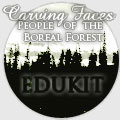Trapping Muskrats
Clip Synopsis:
The Heritage Community Foundation, with the kind permission of Terry Garvin, is pleased to present this feature excerpt from the Bush Land People video.
Aside from beavers, muskrats are a valued source of fur and food to the peoples of the boreal forest. As winter snows melt, push-ups, the dens of muskrats, are exposed to the snares of trappers, and the business of trapping muskrats begins.
Clip Transcription:
As temperatures rise, snow and ice melt. Water levels increase, causing ice to float to the height of the water. When shallow waters open up, trappers use light, easy-to-carry rat canoes to travel across deltas, lakes, and sloughs.
As the shallow water muskrat habitat expands, previously frozen over muskrat dens now become exposed. Traps and snares are set on surface passages into the dens. Fleshed muskrat hides have to be turned inside out, stretched, airdried, and stored. The muskrat meat that is not roasted and eaten by trappers is used to feed dogs, each of which can easily devour between two to three kilograms of meat each day, almost as much as a hungry trapper.





